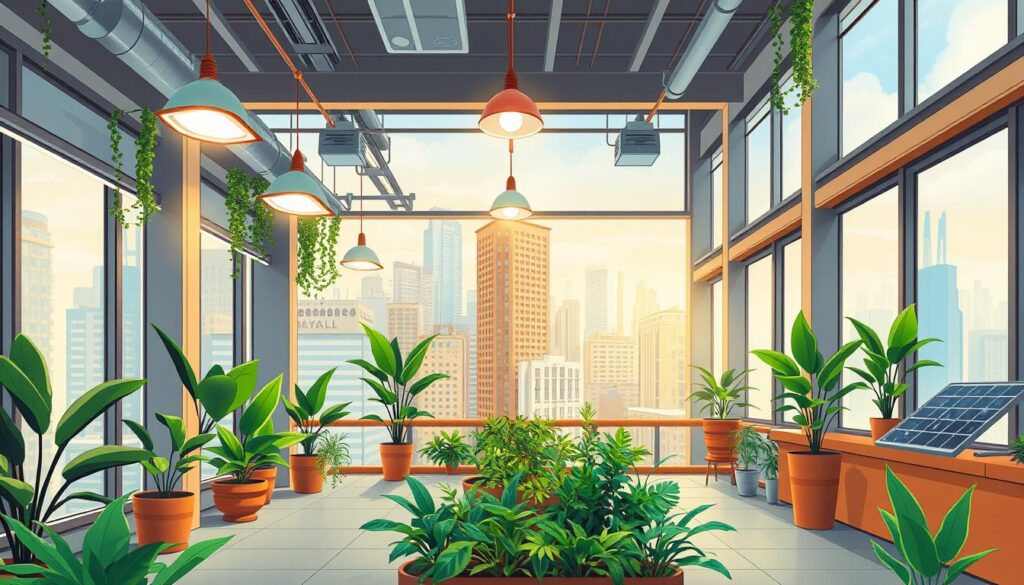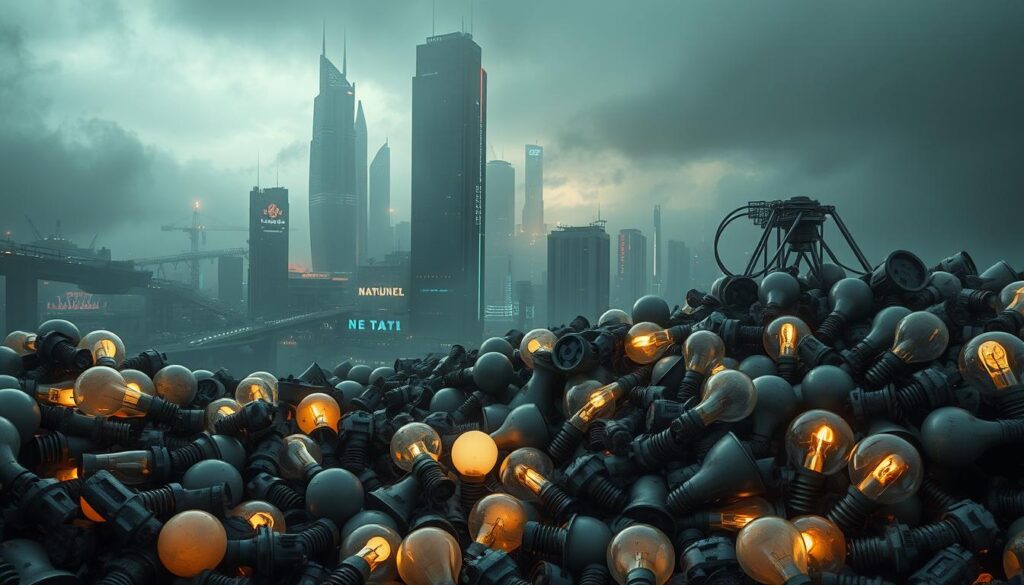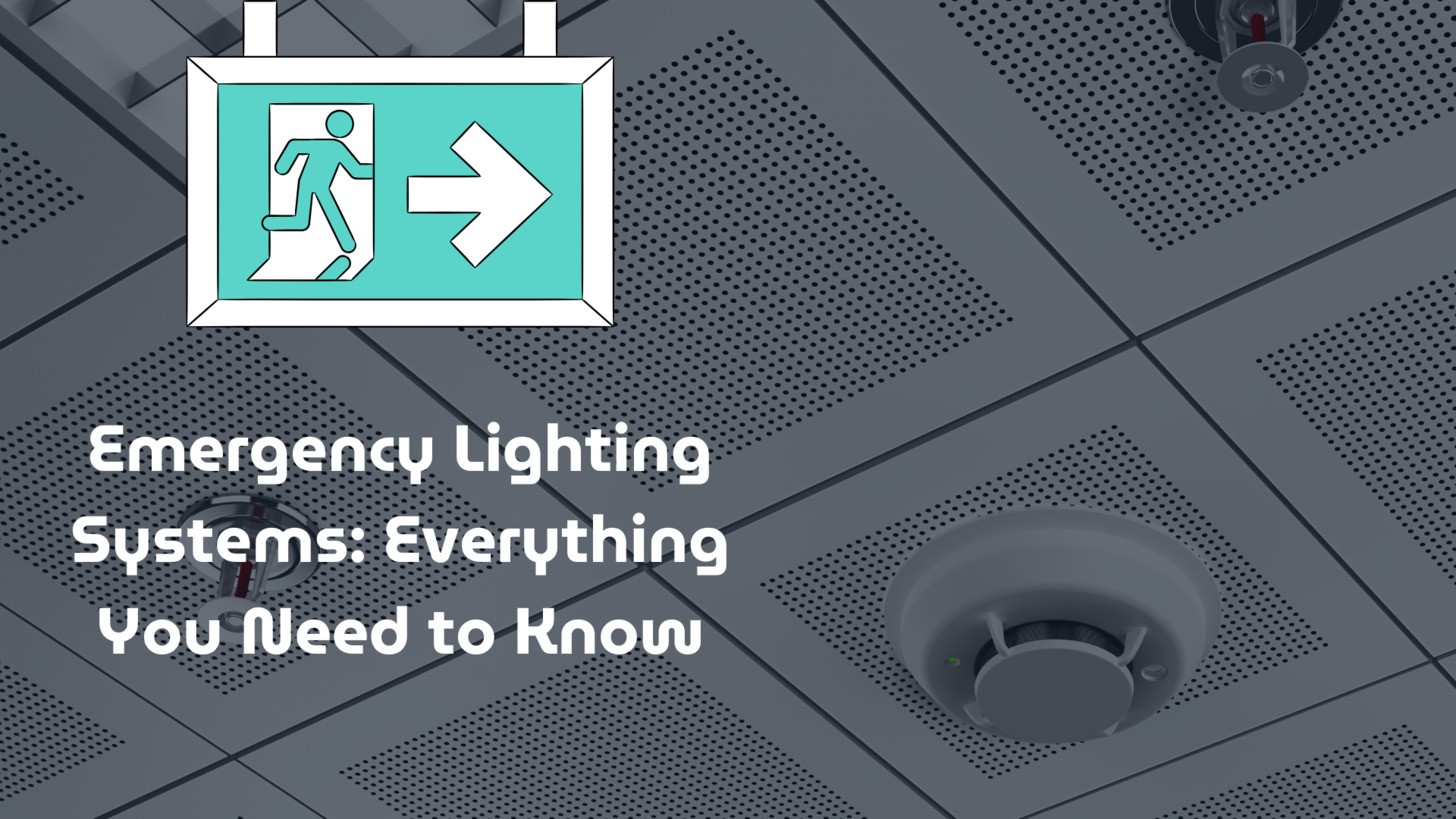Did you know that up to 100,000 light fittings are removed weekly in the UK? Most of these end up in waste streams. This unsustainable practice results in an annual CO2 emission equivalent of 156,000 tonnes. One completely avoidable culprit, is the CAT A fitout.
Real estate developers install new lights in speculative office buildings as part of CAT A fit-outs. These are then replaced by tenants with bespoke CAT B fittings. This cycle of waste is not only environmentally damaging but also financially inefficient. It’s time to address the CAT A lighting problem in the UK.
In this article, we’ll explore sustainable alternatives to traditional CAT A lighting practices. We’ll discuss the environmental and financial implications of the current system. We’ll also provide practical solutions to help you future-proof your commercial lighting systems.
By understanding the scale of the problem and the available solutions, we can work towards a more sustainable and cost-effective approach.
Understanding CAT A Lighting and Its Environmental Impact
In the UK, CAT A fit-outs are commonplace in the commercial lighting scene, leading to significant environmental harm. These standardised office setups are convenient but neglect the long-term sustainability of their lighting systems.
The Scale of Waste in Numbers
CAT A fit-outs produce between 30 to 100 kilograms of carbon dioxide equivalent (CO2e) per square metre. Lighting alone accounts for around 11 kilograms. Adding tenant fit-outs, the total carbon footprint jumps to 25 to 75 kilograms of CO2e per square metre, with lighting contributing 13 kilograms.
Despite the multiple fit-outs in a building’s 60-year lifespan, the tenant fit-out is often overlooked. This neglect contradicts the industry’s growing commitment to net zero and sustainable practices.
Carbon Footprint Analysis
The environmental impact of these lighting practices is substantial. LED luminaires and advanced lighting control systems could significantly reduce commercial spaces’ carbon footprint. Yet, their adoption is limited. It’s essential to embrace sustainable lighting technologies to meet environmental goals.
Current Recycling Statistics
The industry also grapples with improper disposal and recycling. Only 7% of discarded lights are recycled correctly, with the rest contributing to e-waste.
| Metric | Value |
|---|---|
| CAT A Fit-out Carbon Footprint | 30 to 100 kg CO2e/m² |
| Lighting Contribution to CAT A Fit-out | 11 kg CO2e/m² |
| CAT B Fit-out Carbon Footprint | 25 to 75 kg CO2e/m² |
| Lighting Contribution to CAT B Fit-out | 13 kg CO2e/m² |
| Discarded Lights Recycled Appropriately | 7% |

The Current State of Commercial Lighting in British Offices
The traditional CAT A lighting in British offices often doesn’t meet the needs of modern commercial spaces. It’s designed mainly for generic open-plan layouts, failing to support functionality, productivity, and occupant wellbeing. This rigid approach hinders the lighting industry’s ability to offer innovative, integrated solutions that add value and enhance brand identity.
The UK’s commercial lighting needs a significant shift towards sustainability and flexibility. Intelligent lighting design, tailored to each workspace’s specific needs, is essential. By adopting BREEAM-compliant lighting strategies, businesses can reduce their environmental footprint. They can also create office environments that inspire and engage their workforce.
| Key Challenges of Traditional CAT A Lighting | Benefits of Intelligent Lighting Design |
|---|---|
|
|
By adopting a sustainable, flexible approach to commercial lighting, UK businesses can create offices that meet operational needs and support an eco-friendly future.
Why Traditional CAT A Lighting Practices Are Unsustainable
In the United Kingdom, the traditional CAT A lighting approach in commercial offices is no longer viable. This method, which involves the removal and replacement of nearly-new light fittings, is harmful to the environment and wasteful financially. It fails to adapt to individual needs, leading to unnecessary costs and environmental damage.
Environmental Consequences
The environmental impact of CAT A lighting is alarming. It’s estimated that up to 100,000 light fittings are removed weekly in the UK. This equates to an annual CO2 emission of 156,000 tonnes. Such practices heavily burden our planet, undermining efforts to reduce carbon footprints and support sustainable development.
Financial Implications
The constant replacement of nearly-new fixtures under CAT A is a significant waste of resources. Businesses face unnecessary costs for purchasing, installing, and disposing of these fittings. Often, these costs are incurred without considering energy efficiency or long-term sustainability. This financial strain limits businesses’ ability to invest in sustainable lighting solutions.
Energy Efficiency Concerns
Generic lighting solutions, typical in traditional CAT A approaches, often neglect occupant needs. This lack of customisation results in unnecessary energy consumption and increased operational costs. Moving to energy-efficient and human-centric lighting systems can reduce environmental impact and lead to long-term cost savings.
| Metric | Traditional CAT A Lighting | Sustainable Lighting Alternatives |
|---|---|---|
| Environmental Impact | 156,000 tonnes of CO2 emissions annually | Significantly reduced carbon footprint |
| Financial Implications | Substantial waste of resources, high replacement costs | Long-term cost savings through energy efficiency and human-centric design |
| Energy Efficiency | Generic solutions, leading to unnecessary energy use | Customised, energy-efficient systems tailored to occupant needs |
Sustainable Alternatives to Traditional Fit-outs
In the pursuit of reducing environmental impact, sustainable alternatives to traditional office lighting are becoming more popular. These innovative methods not only cut down on waste but also encourage the use of energy-efficient and sustainable lighting technologies.
Sample floors are increasingly being used, allowing tenants to experience the lighting and atmosphere before committing. This approach enables the reuse of luminaires, ceilings, and floors, significantly reducing environmental costs associated with frequent refurbishments.
Architectural lighting and ceiling design for retention is another sustainable solution. It ensures that existing infrastructure can be repurposed, not discarded. Virtual reality (VR) and augmented reality (AR) technology by letting agents also offer immersive experiences. This reduces the need for physical site visits and sample installations.
Many companies now provide reconditioning services for commercial lighting fixtures, including testing and warranty provisions. This service allows businesses to prolong the life of their existing luminaires. It reduces the demand for new equipment and the environmental impact that comes with it.
Platforms like Recolight’s Reuse Hub offer thousands of new and nearly-new commercial luminaires. They provide a valuable resource for businesses looking for energy-efficient and sustainable lighting solutions.
| Sustainable Lighting Alternatives | Benefits |
|---|---|
| Sample floors | Reuse of luminaires, ceilings, and raised floors |
| Architectural lighting and ceiling design for retention | Retaining existing infrastructure, reducing waste |
| VR and AR technology for immersive experiences | Reducing the need for physical site visits and sample installations |
| Lighting reconditioning services | Extending the lifespan of existing luminaires |
| Reuse platforms for commercial luminaires | Providing access to energy-efficient and sustainable lighting solutions |
By adopting these sustainable alternatives, businesses can benefit from cost-effective and energy-efficient lighting solutions.
Implementing Intelligent Lighting Design Solutions
In the pursuit of sustainable commercial lighting, the introduction of intelligent lighting design solutions marks a significant shift. These advanced methods adhere to human-centric lighting principles. They integrate smart control systems with energy-efficient management strategies.
Human-centric Lighting Approaches
The human-centric lighting design focuses on occupant well-being and productivity. It employs customisable lighting systems, like those powered by Casambi controls. These systems enable employees to adjust lighting settings to their liking, improving their work environment.
Smart Control Systems Integration
Integrating smart control systems into lighting design is essential for energy efficiency and user satisfaction. These systems use sensors to monitor occupancy, natural light, and temperature. They automatically adjust lighting to optimise energy use and create a comfortable work environment.
Energy Management Strategies
At the core of sustainable intelligent lighting design are effective energy management strategies. These strategies utilise sensor-based automation and intelligent control algorithms. They adjust light levels based on occupancy and natural light, reducing energy consumption while maintaining optimal illumination.
| Key Features | Benefits |
|---|---|
| Customisable lighting with Casambi controls | Improved employee productivity and well-being |
| Sensor-based occupancy and daylight monitoring | Optimised energy usage and cost savings |
| Automated lighting adjustments | Flexible, adaptive lighting for diverse work environments |
By adopting these intelligent lighting design solutions, companies can establish sustainable, energy-efficient lighting systems. These systems enhance workforce well-being and productivity while significantly reducing environmental impact.
BREEAM-Compliant Lighting Strategies
Implementing BREEAM-compliant lighting strategies is vital for creating sustainable, energy-efficient commercial environments. BREEAM, or the Building Research Establishment Environmental Assessment Method, is a leading global assessment tool. It evaluates the environmental performance of buildings. By aligning lighting solutions with BREEAM standards, businesses can ensure their offices provide optimal illumination. They also minimise their carbon footprint and environmental impact.
High-efficiency LED luminaires are a key aspect of BREEAM-compliant lighting. LED technology offers superior energy savings compared to traditional lighting sources. This reduces electricity consumption and greenhouse gas emissions. Advanced control systems and daylight harvesting solutions further enhance energy efficiency. They allow for precise management of lighting levels based on occupancy and natural light availability.
| BREEAM Lighting Criteria | Sustainable Lighting Technologies |
|---|---|
| Energy Efficiency | LED luminaires, daylight sensors, occupancy controls |
| Environmental Impact | Reduced carbon emissions, recyclable materials |
| Occupant Comfort | Human-centric lighting, glare control, colour temperature adjustment |
By adopting BREEAM-compliant lighting strategies, businesses can meet stringent environmental standards. They also create workspaces that prioritise employee well-being and productivity. This holistic approach to lighting design ensures a sustainable, future-proof solution. It aligns with the growing demand for eco-friendly commercial spaces.
Cost-Effective Retrofit Services and Solutions
Businesses are now focusing more on sustainability and energy efficiency. This shift has led to a growing need for cost-effective lighting retrofit services. Companies in this field offer innovative solutions. They can revamp existing lighting systems, cutting down energy use and maintenance costs while maintaining performance.
Reconditioning Existing Systems
These retrofit specialists excel in reconditioning existing lighting systems. They conduct thorough tests and offer warranty programmes. This way, they can refurbish and enhance older luminaires, extending their life and boosting efficiency. This method supports a circular economy, reducing waste and maximising the use of existing infrastructure.
Upgrading to LED Technology
They also seamlessly integrate LED luminaires into current lighting setups. Switching to the latest energy-efficient LED technology helps businesses slash energy bills and carbon emissions. It also improves the quality and functionality of office lighting. This move to sustainable lighting retrofit services benefits the environment and the company’s finances.
These cost-effective solutions offer a smart, sustainable alternative to traditional lighting methods. They enable businesses to improve their environmental impact while reducing operational costs. By working with these specialised retrofit service providers, companies can future-proof their lighting systems and support a greener future.
Best Practices for Sustainable Commercial Lighting
Creating sustainable commercial lighting solutions involves several key practices. Businesses can significantly reduce their environmental impact and energy costs by adopting these strategies. By embracing sustainable lighting technologies and energy-efficient lighting approaches, companies can play a vital role in a greener future.
Designing for flexibility and longevity is a fundamental best practice. Modular lighting systems, such as the M-Line Linear range, enable customisation from CAT A to CAT B spaces. This ensures the lighting infrastructure can evolve with office needs, reducing waste and future-proofing the system.
Integrating daylight harvesting systems is another effective strategy. By harnessing natural sunlight and managing artificial lighting intelligently, businesses can cut energy consumption and carbon footprint. Smart control technologies, like occupancy sensors and dimmable luminaires, optimise energy use and enhance comfort.
Lastly, prioritising energy-efficient LED luminaires is essential. LED technology stands out for its efficiency, longevity, and maintenance benefits, making it a sustainable choice. Combining LED luminaires with advanced control systems leads to significant energy savings and supports a sustainable future.
Adopting these best practices for sustainable commercial lighting profoundly impacts a business’s environmental footprint. It also brings financial benefits through lower energy costs and enhanced occupant satisfaction.
The Role of LED Luminaires in Modern Office Spaces
LED luminaires are making office lighting so much more energy-efficient and sustainable. They’ved changed how we light our workplaces, bringing loadss of benefits for modern offices. These advancements meet the evolving needs of today’s workspaces.
Energy Efficiency Benefits
LED luminaires are known for their high energy efficiency, using much less electricity than traditional lights. They can cut energy use by up to 50% or more. This leads to big savings on costs and a smaller environmental impact. It supports the trend towards sustainable office practices.
Maintenance Advantages
LED luminaires also have a long lifespan, lasting 50,000 to 100,000 hours or more. This means less maintenance and lower costs for replacements. It makes lighting systems more cost-effective and keeps workplaces running smoothly.
LED luminaires are also versatile, fitting well with smart control systems. This lets managers control energy use and tailor lighting for everyone. Features like daylight harvesting and occupancy sensors make offices smarter and more user-friendly.
The need for energy-efficient and sustainable offices is rising. LED luminaires are key in modern office design. They save energy, offer better maintenance, and enable smart lighting systems. By using LED technology, companies can create efficient, productive, and green offices for the future.
Future-Proofing Office Lighting Systems
The longevity and adaptability of commercial lighting systems are vital. By adopting intelligent lighting design and smart control systems, facility managers can ensure their office spaces remain relevant. This approach helps them stay ahead of changing needs and regulatory shifts.
The Glide 177 LED Batten The Glide 177 is a great swap for T5/T8 fluorescent lighting, offering a super-efficient 131 lumens per watt. This 1200 mm batten is perfect for all sorts of spaces, delivering bright, reliable light. Built with a tough aluminium body and an opal diffuser, it gives off smooth, even lighting with minimal glare.
It’s packed with handy features like BESA mounting points, conduit entry options, and easy upgrades for DALI, emergency, sensors, Hubsense, or Bluetooth. Plus, with a 50,000-hour lifespan, it keeps shining with hardly any upkeep needed. The integration of smart control systems, like Casambi wireless controls, makes it simple for facility managers to tweak lighting settings. This can be done without the need for major infrastructure overhauls.
Another critical aspect is prioritising sustainability and energy efficiency in lighting design. Opting for LED luminaires and implementing effective energy management strategies is essential. This not only ensures compliance with evolving environmental regulations but also leads to long-term cost savings.
- Embrace modular lighting systems for maximum flexibility
- Integrate smart control technologies for effortless adjustments
- Prioritise energy efficiency and sustainability in lighting design
By strategically implementing intelligent lighting design and smart control systems, facility managers can future-proof their office lighting. This creates spaces that are not only adaptable but also energy-efficient. They align perfectly with the evolving demands of modern workplaces.
Conclusion
The shift towards CAT A lighting in the UK is vital for the industry’s environmental footprint and for creating adaptable, energy-efficient office spaces. By adopting sustainable lighting technologies and intelligent design, the commercial sector can cut waste, lower carbon emissions, and add value for building owners and users.
Key to achieving these goals is the use of LED luminaires, smart control systems, and energy management strategies. Retrofitting existing lighting and focusing on reuse and recycling also supports a circular economy, aligning with net-zero targets. As the need for commercial lighting solutions that focus on sustainability and energy efficiency grows, the industry must be ready to meet this challenge.
By embracing sustainable practices, the UK’s commercial lighting sector can pave the way for a greener future. It will also enhance user experiences and reduce operational costs. The time for action is now. Those who embrace this transition will be well-positioned to succeed in the future.
FAQ
What is the scale of waste in the UK’s CAT A lighting practices?
In the UK, up to 100,000 light fittings are removed weekly. Most of these end up in waste streams. This contributes to an annual CO2 emission equivalent of 156,000 tonnes.
What is the carbon footprint of traditional CAT A and CAT B fit-outs?
CAT A fit-outs produce 30 to 100kg of CO2e/m2, with lighting adding 11kg. CAT B fit-outs add another 25 to 75kg CO2e/m2, with lighting contributing 13kg. The tenant fit-out is rarely included in life cycle modelling, despite multiple fit-outs in a building’s 60-year lifespan.
What is the current recycling rate for discarded lights?
Only 7% of discarded lights are recycled appropriately. The rest typically end up in waste streams.
How do traditional CAT A lighting practices impact functionality, productivity, and occupant wellbeing?
Traditional CAT A lighting is often designed for generic open-plan spaces. It’s hard to adapt to specific needs. It frequently fails to support functionality, productivity, or occupant wellbeing. This limits the industry’s ability to deliver innovative and integrated lighting solutions.
What are the environmental and financial implications of the current CAT A lighting practices?
The environmental impact is significant, with up to 100,000 light fittings removed weekly in the UK. This contributes to 156,000 tonnes of CO2 annually. Financially, the constant replacement of nearly-new fixtures represents a substantial waste of resources. Energy efficiency is compromised as generic lighting solutions often fail to meet specific needs.
What are some sustainable alternatives to traditional CAT A fit-outs?
Sustainable alternatives include installing sample floors and designing architectural lighting and ceilings for retention. Using VR and AR technology by letting agents is also beneficial. Reusing luminaires, ceilings, and raised floors can mitigate environmental impact.
How can intelligent lighting design solutions address the issues with traditional CAT A lighting?
Intelligent lighting design solutions focus on human-centric approaches. They integrate smart control systems and effective energy management strategies. Customisable lighting using Casambi controls allows employees to adjust dimming and temperature. This boosts productivity and well-being.
What are the key features of BREEAM-compliant lighting strategies?
BREEAM-compliant lighting strategies focus on energy efficiency, occupant comfort, and environmental sustainability. They may include high-efficiency LED luminaires, daylight harvesting systems, and advanced control technologies.
What are the benefits of cost-effective retrofit services for commercial lighting?
Cost-effective retrofit services include reconditioning existing lighting systems and upgrading to LED technology. Reconditioning offers testing and warranty services. Upgrading to LED significantly reduces energy consumption and maintenance costs. This provides a more sustainable approach to lighting.
What are the best practices for sustainable commercial lighting?
Best practices include designing for flexibility and longevity. Integrating daylight harvesting systems and implementing advanced control technologies are also key. Using modular lighting systems, prioritising energy-efficient LED luminaires, and incorporating smart controls can significantly reduce energy consumption and improve occupant comfort.
How do LED luminaires contribute to sustainable office lighting?
LED luminaires are essential in modern office spaces due to their energy efficiency and low maintenance requirements. They consume significantly less energy than traditional lighting systems. This results in lower operational costs and a longer lifespan, reducing the frequency of replacements and associated waste.
How can office lighting systems be future-proofed?
Future-proofing office lighting systems involves implementing flexible and adaptable solutions. This includes using modular lighting systems and incorporating smart control systems, such as Casambi wireless controls. These enable easy adjustments to lighting settings without major infrastructure changes.












